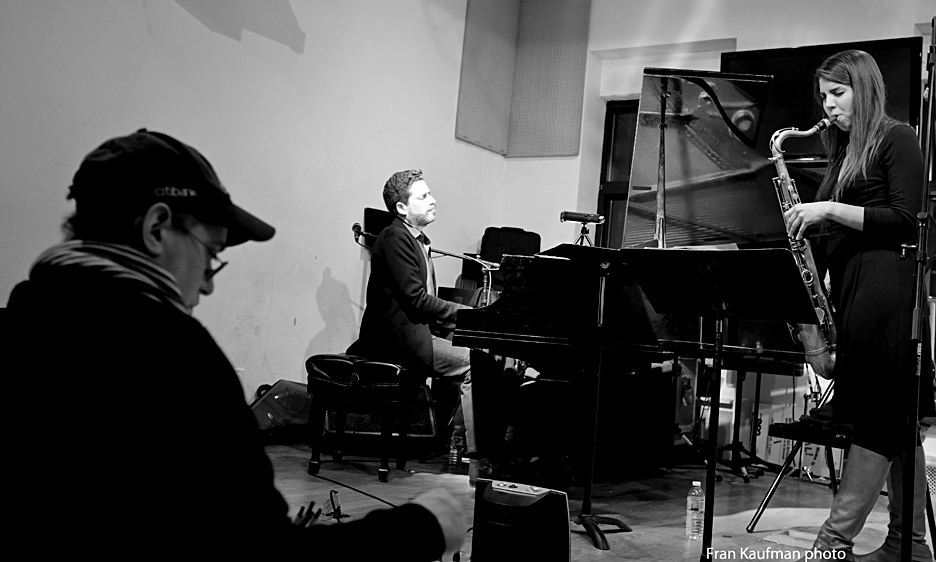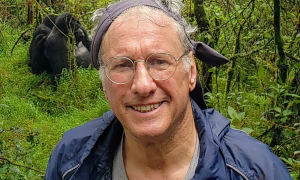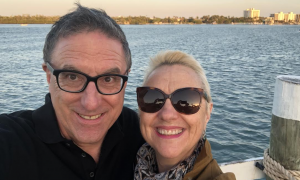Home » Jazz Articles » Out and About: The Super Fans » Meet Jonathan Glass
Meet Jonathan Glass

Courtesy Fran Kaufman
'You’re not drawing me, are you?' he asked. 'Why not?' I responded. 'Because I’ll be playing my sax, looking at the drawing, then playing my sax, then looking at the drawing, and finally I’ll say, ‘that looks like Henry Kissinger.’
—Lee Konitz
Tell us a bit about yourself.
After spending my early childhood in Queens, New York, my family moved to Pleasantville, in Westchester County [New York], when I was 11. I discovered my penchant for drawing at the early age of 10, and studied art throughout my schooling, receiving a BFA from the University of Buffalo.My older brother and I spent hours playing basketball at SUNY Purchase, where the Knicks were often seen practicing their craft. We became big autograph collectors of sports memorabilia, attending sports collector shows and scheming our way into hotels after learning where the teams were staying. I remember duping Larry Bird into giving me a second autograph by assuring him he had not already given me one. We followed the Lakers, Celtics, and the Bulls during the time Michael Jordan was becoming basketball royalty. I finally got to meet MJ the season he won his sixth championship, but he turned down my request for an autograph because he was exhausted.
Another passion of mine is theater. The first musical I saw was Ain't Misbehavin' with Nell Carter. I was blown away by Ms. Carter's soulful voice, and her ability to fill the entire theater with her range and gospel depth. This unforgettable experience made me a lifelong theater devotee, and I have been fortunate to witness Yul Brynner's last performance of The King and I, Anthony Quinn in Zorba, Patti LuPone and Ron Moody in Oliver, Topol in Fiddler on the Roof, and the original cast (minus Richard Kiley) in Don Quixote. It is sad to see the lights go out on Broadway during this stressful time, as it is to see what's happened to the jazz scene in New York as clubs have been forced to shut down.
Besides collecting sports memorabilia and comic books, I have a large collection of Playbills dating back to the 1930's, signed by the likes of Edward Albee and Arthur Miller. I am hoping to get the great lyricist Stephen Sondheim to sign my six playbills from his shows.
What's your earliest memory of music?
My earliest recollections of music were the "Alphabet Song" ("A" my name is Alice..."), Sesame Street ("Sing, Sing a Song"), the Muppets ("The Rainbow Connection"), and Bob Dorough's Schoolhouse Rock. As an adult, I had the pleasure of meeting the great Mr. Dorough, and loved his standards as much as my childhood Saturday morning cartoon memories.How old were you when you got your first record?
I was into rock and pop music. My first album, received when I was about six years old, was High Volume. It was a collection of long-haired rockers, and included the song "Hot Blooded." I remember my parents subscribing to the Columbia House Cassette Club. We ordered cassette albums of Stevie Wonder, Billy Joel, Pat Benatar, Blondie, and Elton John. Family listening time was mostly Billy Joel, but I loved all of them, especially Stevie.What was the first concert you ever attended?
My first live concert experience was a gift from my grandparents to see Al Hirt at Queens College. My brother was learning to play the trumpet and they thought this would encourage him to continue his efforts. I distinctly remember one up-tempo song where Al Hirt sounded like he was playing three trumpets at the same time, yet he was the sole performer on stage. To this day, I try to capture that frenetic energy in my sketches and wonder how he was able to accomplish such a feat.Was there one album or experience that was your doorway to jazz?
There were two inspirations that opened the door for my love and appreciation of jazz. The first took place at a club in Buffalo, NY during my college days. The husband of one of my teachers played with Grover Washington, Jr. and I went to hear them. I also did my first sketch of Branford Marsalis around that time. In an awkward moment: I spilled ink all over myself, and was mortified when Mr. Marsalis chuckled after completing his song. I never finished the sketch, and was chastised for not completing it by my teacher and mentor, Alan E. Cober, who was encouraging me to incorporate my mistakes into my sketches. It was Mr. Cober who taught me about the importance of rendering my drawings to completion no matter the challenge.How long have you been going out to hear live music?
Since I was 15, but it was not until I was 23 it became my focus of music appreciation. In 1996 I got to hear and meet Dave Brubeck, Sonny Rollins, Joe Henderson, and Max Roach. I remembered my college professor telling me to incorporate what I learned about each performer in my sketches, and I continue to do so to this day.How often do you go out to hear live music?
As a security guard during the week, waking up at 5:30 a.m. to get to work on time, and a museum gallery attendant on weekends, I try to attend shows three to five nights a week. Whether I am traveling to Tarrytown, a club in Brooklyn, or closer to home in Manhattan, I derive a great deal of pleasure in the performances, and that keeps me going.What is it about live music that makes it so special for you?
Music uplifts my soul. It is a religious experience for me to be in the presence of great musicians. Performers like Jackie McLean, Keith Jarrett, and Cecile McLorin Salvant, to name a few, connect my sketches and their music as a higher calling. I am often asked which comes first, listening or sketching. The answer is neither, as they work in conjunction with each other. I am aware on two levels, listening with my ears, while having the ability to funnel the music into my sketches.What are the elements of an amazing concert?
An amazing concert doesn't have any requirements other than hearing something that expands my understanding of sonic possibilities. I remember hearing Cecil Taylor live at the Whitney Museum and realizing that what had seemed before to be unstructured freeform had harmonic and melodic elements. It made me appreciate Cecil Taylor with a new level of respect.What is the farthest you've traveled to get to a jazz performance?
I have travelled to the Newport Jazz Festival All Stars, the COTA Festival (annually held in the Delaware Water Gap), Preservation Hall in New Orleans, and to Florida to hear B.B. King. My trip to the Philadelphia Academy of Music to hear Norah Jones stands out, as I remember how lit the stage was lit, and how my front row seat was so dark that I could hardly see my sketchbook. My drawing came out amazing despite the lighting issues, and eventually Ms. Jones signed it.Is there one concert that got away that you still regret having missed?
There are two concerts that got away that stand out in my mind. My ninth grade teacher encouraged me to go to the Blue Note to hear Stephane Grappelli and I'm sorry that I did not go. The other was not going to hear (and sketch) Oscar Peterson at Birdland when he returned for a week after he'd had a stroke.If you could go back in time and hear one of the jazz legends perform live, who would it be?
Without question, it would be Charlie Parker. While living in New York and attending the School of Visual Arts, I became an avid listener of Phil Schaap's "Bird Flight" program on WKCR and really got into the music of Charlie Parker. I would love to have heard him at one of the famous Live at the Philharmonic sessions.What makes a great jazz club?
What makes a great jazz club are the acoustics, the ambiance, the ability to listen uninterrupted and, most importantly, consistently good bookings. My favorite club to draw in is either The Zinc Bar or Jazz Gallery. I feel most welcome to sketch in both venues.I consider the Village Vanguard to be a standout club because of its history and reverence for music, their policy of not catering to celebrities, and having a code of behavior. As to their bookings, you can't have a bad night no matter who is playing. The way the Gordon family has run the club, its consistency since the 1930s remains intact.
Which clubs are you most regularly found at?
Before the pandemic hit, I used to frequent the Zinc Bar, Jazz Gallery, Jazz Standard, Mezz Mezzrow, Smalls Jazz Club, Jazz at Lincoln Center, Jazz at Kitano, Club Bonafide, St. Peter's Church, 55 Bar, Birdland, and the Blue Note.Is there a club that's no longer around that you miss the most?
Two clubs that I miss the most are Cornelia Street Cafe and Zeb's. Cornelia Street had the greatest vibe for experimental music, vocals, and avant-garde jazz, as well as curated music series. While it was disturbing that you could not enter the venue until five minutes before the performance, the acoustics and lineup were great, as was the food.I miss Zeb's because Saul ZebulonRubin is a respected musician who had a great community going. The guitar festivals were the best of the best! And the vocal lineups were killer! Had it not been for high rent issues, both these clubs would still be around, and it is a shame that they are not.
Do you have a favorite jazz anecdote?
The first time I drew the late, great Lee Konitz, I was sitting in the front row. Before he commenced playing he looked right at me and said, "You're not drawing me, are you?" "Why not?" I responded. "Because I'll be playing my sax, looking at the drawing, then playing my sax, then looking at the drawing, and finally I'll say, 'that looks like Henry Kissinger.'" "As long as you don't act like Henry Kissinger," rang out from a heckler in the audience! When Lee said "I wish you wouldn't," I respectfully put down my pen and ink.In between sets, I went up to Lee and asked if it would be okay to draw him if I moved to the third row, where I'd be less distracting. He responded, "Do whatever you like." In the middle of the next set, while playing a five-minute solo on "All the Things You Are," Lee stopped performing, looked over at me and asked, "How's it going, Picasso?"
How do you discover new artists?
Mainly word of mouth. I consistently keep abreast of who to listen to by talking with other super fans, like Don Shire, Jeff Putterman, Doug Pulaski, Heidi Glaeser, Steve Lambert, and David Mitchell. I respect their opinions and they respect my art. Also, I tend to go to progressive places that help develop talent, like the Jazz Gallery, Smalls, BRIC, Winter Jazzfest, COTA (Celebration of the Arts), the Vision Festival, and Le Poisson Rouge.Vinyl, CDs, MP3s, streaming?
Definitely CD's. I like collecting physical copies to support artists and take home the music from the shows I love. I want to support musicians like Anat Cohen, Dave Douglas, and Fabian Almazan, who are entrepreneurs for starting their own labels.If you were a professional musician, which instrument would you play and why?
I would play the drums because I have a deep sense of rhythm and love to tackle difficult things. I like the fact that the drums require your whole body to be active.What's your desert island disc?
The Lonely One by Bud Powell, or the Atlantic recordings by Lester Young.What do you think keeps jazz alive and thriving?
Although jazz is now an industry, it is the audience that keeps the live experience going. I am hopeful that during this time of coronavirus, clubs can sustain the loss of audiences until such time that we can congregate safely once again. I would also like to see jazz being exposed to the next generation in order to carry on this genre of music that is deeply rooted in our country.Is there anything else we should know about you?
I am hoping to publish a coffee table book detailing 25 years of sketching live jazz performances within the next year. My work is niche, and a hard sell for mass appeal, but it is important to the history of jazz. I have a book designer and will look for a literary agent to help find the right publisher for this project.One day, I would like to return to studying martial arts. I once practiced Goju-ryu and enjoyed the discipline it afforded me.
I am also an avid photographer, although I don't photograph jazz concerts because the field is already flooded and I prefer to do something unique while I am appreciating the music. My favorite photographer, Henri Cartier-Bresson, once said, "There are a lot of photographers, but not many artists."
Finish this sentence: Life without music would be...
Lifeless! My life, my art, my music help define me. Without those, sadness would prevail!More of Jonathan's sketches can be viewed here.
Tags
Out and About: The Super Fans
Tessa Souter and Andrea Wolper
Nell Carter
Yul Brynner
Anthony Quinn
Patti Lupone
Ron Moody
Richard Kiley
Stephen Sondheim
Bob Dorough
Stevie Wonder
Billy Joel
Pat Benatar
Blondie
Elton John
Al Hirt
Grover Washington, Jr
Branford Marsalis
Dave Brubeck
Sonny Rollins
Joe Henderson
Keith Jarrett
Cecile McLorin Salvant
Cecil Taylor
newport jazz festival
Delaware Water Gap
Preservation Hall
New Orleans
Florida
BB King
Philadelphia Academy of Music
Norah Jones
Blue Note
Stephane Grappelli
Oscar Peterson
Birdland
Charlie Parker
Phil Schaap
Zinc Bar
Jazz Gallery
Village Vanguard
Jazz Standard
Mezzrow
SMALLS
Jazz @ Lincoln Center
Kitano
Club Bonafide
St. Peter's Church
55 Bar
Blue Note
Cornelia Street Cafe
Zeb's
Saul Rubin
Lee Konitz
BRIC
Winterjazz Fest
Vision Festival
Le Poisson Rouge
Anat Cohen
Dave Douglas
Fabian Almazan
Bud Powell
Lester Young
PREVIOUS / NEXT
Support All About Jazz
 All About Jazz has been a pillar of jazz since 1995, championing it as an art form and, more importantly, supporting the musicians who make it. Our enduring commitment has made "AAJ" one of the most culturally important websites of its kind, read by hundreds of thousands of fans, musicians and industry figures every month.
All About Jazz has been a pillar of jazz since 1995, championing it as an art form and, more importantly, supporting the musicians who make it. Our enduring commitment has made "AAJ" one of the most culturally important websites of its kind, read by hundreds of thousands of fans, musicians and industry figures every month.























